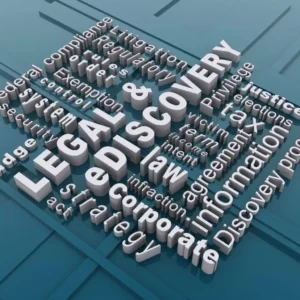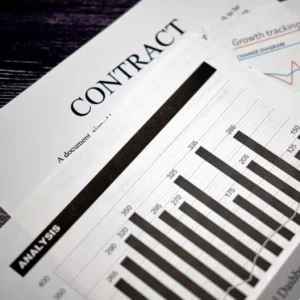
Legal Filing Transformed
AI-Driven Document Categorization
The legal sector, known for its vast libraries of documents and meticulous detail, is undergoing a revolution. At the heart of this transformation is “AI-Driven Document Categorization.”
This article highlights how AI simplifies massive legal document repositories, offers quicker insights, and enhances collaboration. Dive into the nuances of natural language processing, predictive analytics, and machine learning as they redefine document management.
As you journey through this exploration, you’ll grasp the true potential of AI-assisted templates, advanced security protocols, and the future possibilities of the next generation of document management.
So, whether you’re a legal professional, tech enthusiast, or simply curious, prepare for a deep dive into a world where technology and law intertwine seamlessly.
Table of Contents
Making Sense of Vast Document Libraries
The legal industry is synonymous with vast repositories of documents. Traditionally, making sense of these extensive libraries was tedious, often likened to finding a needle in a haystack. Enter AI-driven document categorization. This revolutionary approach uses predictive analytics for document retrieval, ensuring quick, intuitive access. It’s not just about classifying; it’s about understanding content and context.
With the integration of natural language processing for document search, lawyers can now pull relevant documents based on the precise context of their query, reducing hours of manual labour. The system learns from its interactions, optimizing results over time. Furthermore, AI for legal document summaries offers professionals a concise overview without delving into each page, a real-time saver during critical case preparations.
Collaborative efforts aren’t left behind. With machine learning in document collaboration, teams can cohesively work, offering real-time updates. The process ensures seamless document version control and the added benefit of AI-enhanced document version control. Gone are the days of confusing overlaps or missed edits.
As we evolve into this new age of legal filing, one can’t help but wonder: How will AI tools for document lifecycle management redefine how law firms operate in the next decade?
Quick and Intuitive Document Access
Prompt and intuitive access is paramount in a world of digitized records, especially in the legal sector. This transformative method sorts and arranges vast legal files precisely, ensuring every document is at your fingertips.
But how does one pull out a document from this organized heap? Imagine a world where your document retrieval system anticipates your needs and presents relevant papers before you even start a search! With cutting-edge predictive analytics, you can save time and energy by having the most pertinent documents at your fingertips.
No more endless scrolling or frustrating searches – let the system do the work for you. This predictive nature streamlines efforts, leading to enhanced productivity. For a more context-specific hunt, natural language processing for document search emerges as a game-changer. Instead of relying on exact keywords, one can now frame queries in everyday language, making the search process feel human-centric.
Collaborative work also feels smoother. With machine learning in document collaboration, shared files and edits appear in real-time, minimizing confusion. Moreover, AI-enhanced document version control keeps track of changes, ensuring that teams are always on the same page.
Amidst these advancements, one might ponder: How will these AI-infused tools shape the efficiency of future legal professionals?
Auto-Summarization for Quicker Insights
Imagine sifting through a 100-page legal document in mere minutes. With AI for legal document summaries, this isn’t just a dream but an everyday reality. Auto-summarization tools powered by AI extract the essence of hefty files, presenting a condensed overview that is quick to read and understandable.
How does this magic happen? Imagine having an assistant who can quickly analyze and categorize your documents while understanding the content hierarchy. With the help of natural language processing, this AI-powered system can decipher the semantic importance of every segment and provide you with summaries that are coherent and rich in context. It’s like having a brilliant and efficient assistant who can help you stay on your game!
Legal practitioners also benefit from predictive analytics for document retrieval in this realm. While looking for specific insights or clauses, they can jump directly to auto-summarized sections, saving time and energy. When collaboration is critical, machine learning in document collaboration ensures that shared summaries are updated in real time, fostering synchronized teamwork.
In an era where time is at a premium and attention spans are waning, could auto-summarization be the ultimate bridge to efficiency for the legal sector?
Using NLP for Context-Based Searches
Navigating through intricate legal texts requires more than keyword matches; it demands understanding context. Here, natural language processing (NLP) for document search takes centre stage, ushering in an era of intuitive, context-aware searches. Instead of merely locating terms, NLP digs deeper, identifying the nuanced meanings behind legal phrases and jargon.
At its core, this advanced technique relies on AI-driven document categorization. NLP fine-tunes its search capability by comprehending documents’ broader structure and thematic undertones. For instance, searching for “breach of contract” won’t just yield generic results; instead, it might pull up papers specifically addressing penalties or remedies related to such breaches.
Enhancing this process further is the role of predictive analytics for document retrieval. The system anticipates the needs as legal professionals draft queries, offering contextually relevant suggestions. This synergy between NLP and predictive analytics is nothing short of revolutionary. When documents are in collaborative spaces, machine learning ensures that context-based searches are always in sync with the latest edits and inputs.
Amid these advancements, a thought lingers: How might NLP further elevate the precision of legal searches in the coming years?
Seamless Handling of Document Versions
Legal documents are living entities, evolving with every case update, negotiation, or revision. Managing these multiple versions can be daunting, but not with AI-enhanced document version control at the helm. This technology ensures that every update, every edit, and every iteration is catalogued precisely, reducing any chances of oversight.
Central to this is the robust AI-driven document categorization system. It identifies and classifies documents and comprehends the intricate relationships between different versions. When paired with predictive analytics for document retrieval, this interconnected web of arrangements offers a swift transition between drafts, making version comparisons a breeze.
Picture this: you and your team are working on an important document, each adding unique insights and ideas. But instead of worrying about lost contributions or overwritten edits, you’re seamlessly collaborating in a dynamic environment powered by machine learning.
As you type, the AI is working behind the scenes to merge your inputs in real time, creating a comprehensive and consistent document that truly reflects the collective intelligence of your team. With this collaboration, you can confidently tackle complex projects and achieve even greater success.
As the layers of versions accumulate and documents become dense, the reliance on natural language processing for document search also increases, enabling users to pinpoint specific changes across versions.
With such intricate handling of document evolutions, one wonders: How might AI reshape the future of legal document editing and archiving?
More innovative Collaboration and Real-Time Updates
In the bustling corridors of law firms, collaboration is the beating heart. Exchanging drafts, discussing clauses, and aligning strategies require an innovative and swift synergy. Enter the realm of machine learning in document collaboration. This powerful technology enables multiple legal professionals to work on a single document seamlessly, making real-time edits and updates without stepping on each other’s toes.
At the core of this collaboration is the intricate AI-driven document categorization. It organizes documents so teams can instantly locate shared files, dive into specific sections, and make informed edits. This dynamic categorization and predictive analytics for document retrieval ensure that collaborators always find a document’s most recent and relevant version.
And it doesn’t stop there. Natural language processing for document search boosts collaborative efficiency further. Team members can search within shared documents using everyday language, pinpointing exact sections without wading through pages. Moreover, the AI-enhanced document version control is a vigilant gatekeeper, tracking every change and ensuring all edits align with the broader document narrative.
Amidst this collaborative dance of technology and human expertise, a curious thought emerges: How might AI further revolutionize team dynamics in the legal domain?
Preparing Documents with AI-Assisted Templates
Drafting legal documents can often feel like reinventing the wheel. But what if the wheel could self-adjust based on specific needs? AI in legal document templates is doing just that, revolutionizing the way professionals approach drafting. These AI-assisted templates are more than mere formats; they adapt, suggest, and optimize based on the content fed into them.
The underlying magic is, of course, the robust AI-driven document categorization. As a user begins to populate a template, the system understands the context and guides the input process, often suggesting clauses or referencing similar past documents. Furthermore, predictive analytics for document retrieval makes sourcing related document references or precedents almost instantaneous.
Natural language processing for document search is pivotal in these innovative templates. It allows users to search for clauses or legal phrases within the template library, ensuring they get all critical elements. As collaboration remains vital, machine learning in document collaboration allows multiple users to work on the same template in real-time, offering suggestions or making necessary adjustments.
With such advancements simplifying the document preparation process, one can’t help but wonder: What’s next in the world of AI-assisted legal drafting?
Upping the Ante on Document Security
In legal documentation, confidentiality isn’t just a preference; it’s a mandate. As digital threats become sophisticated, so does the need for advanced security measures. Enter AI-driven encryption security. These AI-backed protocols offer more than just password protection. They intelligently analyze access patterns, predict potential threats, and provide real-time defence mechanisms.
At the foundation of these security measures is the intricate AI-driven document categorization. By understanding the sensitivity and relevance of each document, the system tailors its encryption standards. For instance, high-profile case files might get an added layer of protection compared to standard templates.
Furthermore, when professionals retrieve sensitive documents, predictive analytics ensures that only authorized personnel have access. The system may adapt based on behavioural analytics, and offer added checks if it detects any anomalies.
Adding to this security fortress is natural language processing for document search. Even within encrypted documents, NLP ensures professionals can search without compromising confidentiality. And let’s remember machine learning in document collaboration. The AI ensures that all shared versions maintain encryption integrity when sharing documents.
Amid these fortifications, one might ponder: How will AI redefine the essence of legal document confidentiality in the coming years?
Streamlining Document Creation to Archiving
The lifecycle of a legal document isn’t merely about its creation; it encompasses a journey from drafting to eventual archiving. The legal world is now leveraging AI tools for document lifecycle management to ensure this journey is seamless and efficient.
The initial drafting phase has seen remarkable transformations with AI-driven document categorization. As attorneys begin drafting, the system offers suggestions, ensures compliance, and predicts required clauses based on past patterns. This synergy with predictive analytics for document retrieval provides a swift, efficient creation process, pulling in related precedents or clauses as needed.
Once created, documents often undergo multiple revisions. Machine learning in document collaboration ensures real-time updates, track changes, and version controls, ensuring all collaborators are on the same page. Natural language processing for document search becomes invaluable as these documents near their final forms allowing professionals to cross-reference or validate specific sections quickly.
Eventually, when it’s time for archiving, the system understands each document’s significance, relevance, and sensitivity, categorizing them accordingly for future retrieval or reference.
With this streamlining of processes, a thought emerges: How might AI further refine the intricacies of document lifecycle management in the future legal landscape?
The Next Generation of Document Management
Imagine a legal landscape where documents virtually manage themselves. This isn’t a distant dream but the budding reality of the next generation of document management. Rooted deeply in AI-driven document categorization, the future offers an ecosystem where documents are not just static files but dynamic entities that interact, evolve, and adapt.
One can anticipate a world in which predictive data for document retrieval becomes so precise that before a lawyer even thinks of a file, and the system presents it. This intuition is bolstered by natural language processing for document search, making file retrieval as simple as asking a colleague across the table.
Collaboration is poised to take a quantum leap with machine learning in document collaboration. Future platforms might allow virtual, holographic unions, with AI-powered assistants suggesting edits, cross-referencing case law, and even predicting case outcomes based on document content.
Furthermore, AI-enhanced document version control could autonomously merge changes, flag inconsistencies, and even set up meetings when collaborators’ suggestions clash.
With such futuristic visions on the horizon, the natural question arises: As AI becomes increasingly integrated with document management, it begs the question – what will humans’ new role be in legal documentation? Join me as we explore the possibilities of this exciting future.
Concluding Thoughts: The Legal Documentation Revolution
The legal sector stands at the cusp of a transformative era powered predominantly by AI-driven document categorization. This evolution simplifies vast document libraries and ensures quick, intuitive access, transforming how professionals interact with data. But what about gaining insights from these documents?
Enter auto-summarization for quicker insights and natural language processing for document search. Do you wish you had the power to effortlessly navigate through a vast ocean of information and seamlessly locate the exact piece of information you need without getting lost in the chaos? That’s the kind of game-changing ability professionals gain when using these tools.
With the ability to streamline decision-making processes, they’ll have more time to focus on what matters. By leveraging the power of AI to enhance document version control, we can work together seamlessly and efficiently on document iterations. This ensures everyone is on the same page, making collaboration a breeze.
Speaking of collaboration, the amalgamation of machine learning in document collaboration and AI-assisted templates promises real-time updates and smarter drafting. But while innovation thrives, security remains paramount. AI-driven encryption and protection is upping the ante, ensuring that as documents become innovative, they also become safer.
AI tools for document lifecycle management are redefining every step, from the initial drafting phase to the final archiving. So, as we glance into the future of the next generation of document management, it’s clear: AI isn’t just an accessory; it’s integral.
To answer the lingering question of the human role amidst this AI-driven revolution, Humans will evolve from mere drafters or managers to strategic orchestrators, leveraging AI’s power for deeper insights, more robust strategies, and more impactful legal interventions. The future is not just about more innovative documents but a more creative, more efficient legal world.
Related Articles
- AI in Pro Bono Case Selection: Maximizing Impact
- AI in Alternative Dispute Resolutions: The New Mediator
- AI in Courtroom Support: Revolutionizing Evidence Compilation
- AI-Driven IP Management: From Patents to Trademarks
- AI-Driven Document Categorization: Legal Filing Transformed
- AI in Compliance Monitoring: Legal Standards and Predictive Oversight
- AI-Driven Legal Chatbots: Future of Attorney-Client Interactions
- AI-Driven E-Discovery Platforms: Enhanced Efficiency and Precision
- AI-driven Legal Analytics: Transforming Decision-making and Litigation Strategies
- AI-Driven Legal Research: How Technology is Reshaping the Future of Law
- AI for Contract Analysis: Streamlining Processes and Predicting Success
- Other Articles on AI Usage in Legal
- Other Articles on AI usage in different industries
























